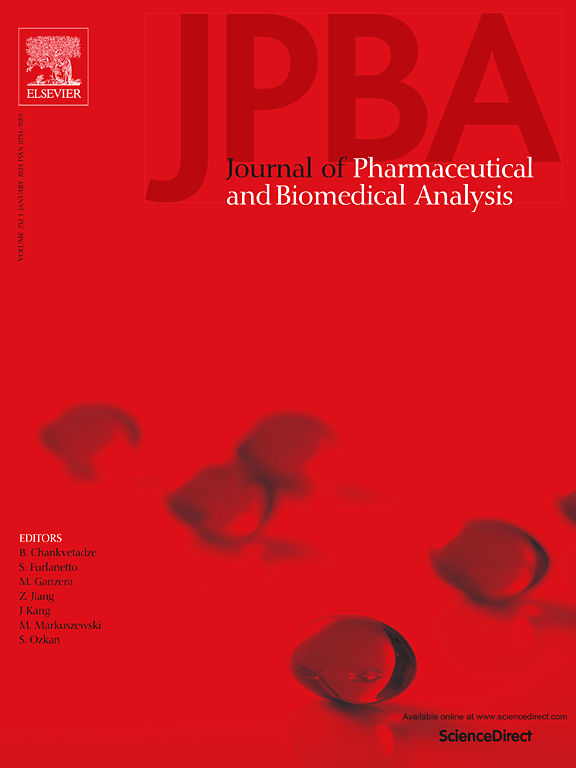通过超高效液相色谱-Q-外活性轨道rap质谱仪鉴定大鼠体内的月桂苷代谢物
IF 3.1
3区 医学
Q2 CHEMISTRY, ANALYTICAL
Journal of pharmaceutical and biomedical analysis
Pub Date : 2024-09-19
DOI:10.1016/j.jpba.2024.116482
引用次数: 0
摘要
蝙蝠葛碱是从蝙蝠葛根中提取的一种双苄基异喹啉生物碱,具有多种生物活性,包括抗血小板、抗炎、神经保护和抗肿瘤等特性。然而,以往的研究并没有全面阐明月桂苷在体内的代谢概况和途径。我们采用超高效液相色谱-Q-Exactive Orbitrap质谱技术,全面研究了Sprague-Dawley大鼠胃内给药后多瑞索林的代谢产物。通过全扫描 MS/dd-MS2,结合平行反应监测、提取离子色谱和诊断碎片离子,加强了数据收集和分析。共检测到 63 种代谢物,其中包括 62 种新型代谢物和古柯碱。这项研究阐明了月桂苷代谢的裂解模式和组织分布特征。此外,还对脱氢、羟化、甲基化、硫化和葡萄糖醛酸化等体内反应进行了深入研究。通过研究大鼠体内的多瑞索林代谢物,加深了我们对其体内代谢的了解,有助于阐明其代谢和药理作用。这为进一步研究其疗效奠定了宝贵的基础。本文章由计算机程序翻译,如有差异,请以英文原文为准。
Identification of daurisoline metabolites in rats via the UHPLC-Q-exactive orbitrap mass spectrometer
Daurisoline, a bisbenzylisoquinoline alkaloid extracted from the rhizomes of Menispermum dauricum, exhibits diverse biological activities, encompassing antiplatelet, anti-inflammatory, neuroprotective, and antitumor properties. However, previous investigations have not comprehensively elucidated the metabolic profile and pathways of daurisoline in vivo. Using Ultra-High-Performance Liquid Chromatography with Q-Exactive Orbitrap Mass Spectrometry technology, we comprehensively investigated the metabolites of daurisoline in Sprague-Dawley rats, following intragastric administration. Data collection and analysis were enhanced through Full Scan MS/dd-MS2, in conjunction with parallel reaction monitoring, extracted ion chromatography, and diagnostic fragment ions. Sixty-three metabolites were detected and characterized, including sixty-two novel metabolites and coclaurine. This investigation elucidated the cleavage patterns and tissue distribution characteristics of the metabolism of daurisoline. Furthermore, in vivo reactions, including dehydrogenation, hydroxylation, methylation, sulfation and glucuronidation, were thoroughly examined. Investigating the metabolites of daurisoline in rats has deepened our understanding of its metabolism in vivo, aiding in elucidating its metabolic and pharmacological actions. This provides a valuable foundation for further research into its therapeutic efficacy.
求助全文
通过发布文献求助,成功后即可免费获取论文全文。
去求助
来源期刊
CiteScore
6.70
自引率
5.90%
发文量
588
审稿时长
37 days
期刊介绍:
This journal is an international medium directed towards the needs of academic, clinical, government and industrial analysis by publishing original research reports and critical reviews on pharmaceutical and biomedical analysis. It covers the interdisciplinary aspects of analysis in the pharmaceutical, biomedical and clinical sciences, including developments in analytical methodology, instrumentation, computation and interpretation. Submissions on novel applications focusing on drug purity and stability studies, pharmacokinetics, therapeutic monitoring, metabolic profiling; drug-related aspects of analytical biochemistry and forensic toxicology; quality assurance in the pharmaceutical industry are also welcome.
Studies from areas of well established and poorly selective methods, such as UV-VIS spectrophotometry (including derivative and multi-wavelength measurements), basic electroanalytical (potentiometric, polarographic and voltammetric) methods, fluorimetry, flow-injection analysis, etc. are accepted for publication in exceptional cases only, if a unique and substantial advantage over presently known systems is demonstrated. The same applies to the assay of simple drug formulations by any kind of methods and the determination of drugs in biological samples based merely on spiked samples. Drug purity/stability studies should contain information on the structure elucidation of the impurities/degradants.

 求助内容:
求助内容: 应助结果提醒方式:
应助结果提醒方式:


